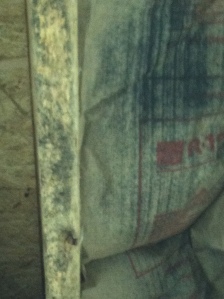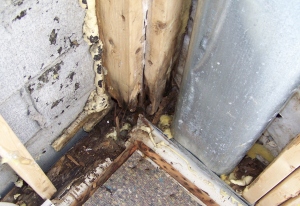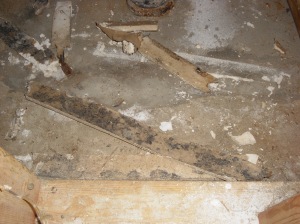A common practice in multi-story apartment and condominium complexes is to house the furnaces in closets that are located on the patio or balcony for each unit. The closets are aligned vertically in each building. Although the orientation is convenient for plumbing access, numerous water damage issues are inherent to this type of HVAC set-up.
Water damage from plugged condensate drain tubes or malfunctioning condensate drain pans is common. Slimy biological growth in PVC tubing and drain pans pan causes overflows. Current or historical overflows from the pans will appear on the sheet metal plenum under the A-coil. Drips and mold growth from malfunctioning units above a closet are commonly apparent as drip stains or growth on the ceiling and walls of the closet.
Water damage caused by freezing and thawing of the AC coils is common in apartment HVAC systems. Filter changes are often left in the hands of uninformed tenants. Plugged filters prevent sufficient air flow to the coil, causing it to freeze. As the coil warms up, the ice thaws, releasing large amounts of water into the return plenum, floor system of the apartment, furnace platform, or furnace closet below the damaged unit.
Another issue associated with stacked HVAC closets is the installation of the furnace on a platform, which is commonly constructed from plywood, drywall, or oriented strand board. When wet, all of these materials support the growth of mold and bacteria, which can produce various toxins. Additionally, the glues and resins in these materials can be liberated when wet.
The return plenum in furnace closet systems is located beneath the platform, with the underside of the platform being the top of the plenum, a concrete slab serving as the bottom, and the walls of the platform forming the sides of the plenum. In addition to being difficult to clean, a water damaged common plenum provides both a contaminant source and transport pathway. Dust mites, insects and their fecal material, garbage, cigarette butts, contaminated chunks of paper, and rodent feces are just a few of the treasures that have been recovered from plenums under furnace platforms.
When damage does occur, the underlying cause of water must be corrected. This involves replacing plugged drain tubing, cleaning drip pans, cleaning coils, and changing filters. For consistency, preventive measures in the form of routine inspections and HVAC maintenance should be the responsibility of the management company or maintenance staff.
Addressing the consequences of the water damage, whether it manifests as biological growth or deteriorated building materials, is imperative to appropriate HVAC hygiene and good indoor air quality. Contaminants on water damaged plywood, OSB, and drywall in the furnace closet and on the furnace platform can cause adverse health effects, whether the growth is active or historical. Once dried, mold and bacteria engage in survival mechanisms that can include toxin production and increased sporulation. When dry, the contaminants are easily liberated into the airstream. Mold remediation is required when building materials in furnace closets become contaminated. The remediation involves two components (1) removal of the mold or contaminated building material and (2) addressing spores that are released from areas of actual growth. Engineering controls, containment barriers, HEPA filtered air filtration devices, personal protective equipment, HEPA vacuuming, and damp-wiping are all essential for safe and effective remediation in water damaged furnace closets.















